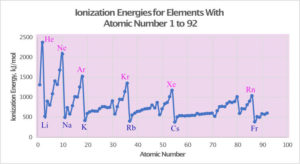The ionization energy, Ei, is the energy required to remove an electron from an atom in the gas phase. Ionization energy tends to increase as we go across a period in the periodic table and decreases as we go down a group. The ionization energies are highest for the noble gases and lowest for the Group 1A metals as shown in the figure below.
Ionization energies are always positive, because energy is required to remove an electron from an atom. The metals have lower ionization energies than the nonmetals. This can be explained in terms of the electron configurations of the atoms. As we move across a period, Zeff increases because electrons in the same shell are not shielded as well. This means the electrons are held more tightly to the nucleus and it will take more energy to remove the electron from the atom. Going down a group, shells are being added and the electrons are not as tightly held to the nucleus, therefore, ionization energies decrease going down a group.
There are some exceptions as we go across a period. For example Be (1s22s2) has a larger ionization energy, 899 kJ/mol, than does B (1s22s22p1), 801 kJ/mol. This is because in Be the electron is being removed from a 2s subshell which is held more tightly to the nucleus than the 2p electron in B. It will take more energy to remove the 2s electron. Nitrogen (1s22s22p3), 1402.3 kJ/mol, has a higher ionization energy than oxygen (1s22s22p4), 1313.9 kJ/mol. The electron in the fully filled p orbital of oxygen is more energetic and easier to remove than the electron in nitrogen’s half filled p orbitals.
Electrons of an atom can be successively removed. The energy required to remove an electron is called the first ionization energy, Ei1, second ionization energy, Ei2, third ionization energy, Ei3, and so on. The table below has the ionization energies for the first and second period elements. The second ionization energy is higher than the first ionization energy because it will take more energy to remove an electron from a positively charged particle. The red vertical lines in the figure below show the difference in ionization energies for the valence electrons and the core electrons. For example, it can be seen that once the valence electron is removed from Li (1s22s1), the energy to remove an electron from the filled 1s subshell is significantly larger.
Core electrons do not usually participate in bonding and it would take much more energy to remove a core electron than a valence electron. It is mainly the valence electrons that are involved in bonding. For example, Al loses three electrons to become Al3+ ion.
Al+ (1s22s2) + Energy → Al2+ (1s22s1) + e– Ei2 = 1817 kJ/mol
Al2+ (1s22s1) + Energy → Al3+ (1s2) + e– Ei3 = 2745 kJ/mol
The ionization energies increase, but the 4th ionization energy, Ei4 is much higher because the 4th electron is in a filled 1s shell that holds the core electrons.
It is highly unlikely that Al4+ ions would form.
Exercises
Exercise 1. Arrange the following elements in order of increasing ionization energy: Ar, Al, Na, Cl.
Exercise 2. Phosphorus has a first ionization energy of 1011.8 kJ/mol and sulfur’s first ionization energy is 999.6 kJ/mol. Both P and S are in the same period. Explain why first ionization energy of P is higher than that of S.
Check Solutions/Answers to Exercises
Exercise 3. Magnesium has a first ionization energy of 737.7 kJ/mol and Aluminum is 577.5 kJ/mol. Explain why the first ionization energy is higher for Mg and lower for Al.
Exercise 4. Explain why the fourth ionization energy of boron is so much higher (approximately 8 times higher) than Ei3
Check Solutions/Answers to Exercises
Exercise 5. A second row element has the following ionization energies:
Ei2 = 1757 kJ/mol
Ei3 = 14,849 kJ/mol
Ei4 = 21,007 kJ/mol
What is the likely identity of the element?
Exercise 6. A third row element has the following ionization energies:
Ei2 = 1577 kJ/mol
Ei3 = 3232 kJ/mol
Ei4 = 4356 kJ/mol
Ei5 = 16,091 kJ/mol
What is the likely identity of the element?
Check Solutions/Answers to Exercises
Back to Periodic Trends and Ionic Compounds
Back to General Chemistry 1 Study Guides
Back to Home Page

